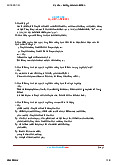
Preview text:
17:55 29/7/24
1. Family Violence - Translation
Translating Practice 2 Social issues CÁC VẤN ĐỀ XÃ HỘI SOCIAL ISSUES FAMILY VIOLENCE
Barriers to the detection and reporting of family violence Detection rates of family violence in
EDs are low. Only 10% of those who present with acute family violence–related injuries or
issues will be asked by the attending nurse or physician to volunteer information about the
violence issue. Documentation of violence in the medical record is rare.
Barriers to detection may include system factors, such as inadequate privacy; cultural, social
and gender issues; and/or the health practitioner’s lack of time and education as well as his or
her personal attitudes. The Victorian Royal Commission into Family Violence identified health
professionals as being in a unique position to identify and respond to family violence and
recommended that they receive targeted training to improve their awareness and responses.
Crime statistics in Australia show a general increase in the reporting of family violence. A range
of barriers can inhibit victims’ disclosures, including feelings of fear and shame, concerns about
not being believed or about further victimization, anxiety about possible medical or legal
processes, as well as familial, cultural or religious pressures. In some cases, individuals do not
recognize themselves as victims of violence or may not yet have considered seeking assistance
in respect to their violent partners.
Indigenous women in Australia rarely report violence. Historical interactions with police, such as
forcible removal of children and high rates of Aboriginal death in custody, contribute to
indigenous women fearing for the safety of themselves and their families when police or social
services are involved. Moreover, the lack of accessible and culturally appropriate legal
processes creates further barriers to reporting. The elderly may be prevented from reporting by
fear of further abuse, neglect or the threat of institutionalization.
The Royal Commission into Family Violence highlighted that the following groups; indigenous,
CALD, disabled, elderly, Lesbian, Gay, Bisexual, Transgender, Intersex, Queer/Questioning and
Allied (LGBTIQA), rural, faith community, male victims, women in prison, women in the sex
industry. These individuals face unique barriers to reporting their experiences of family violence
and to accessing appropriate services. Translating materials 1 PhuongLB-AJC about:blank 1/1




